|
|
| |
|
Gujarat Tours |
|
|
|
|
| |
|
|
| |
|
|
| |
|
|
| |
|
|
| |
|
|
| |
|
Gujarat Hotels |
|
|
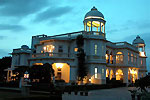 |
|
|
|
|
|
|
|
|
Gujarat Music and
Dance |
|
|
Music
In the field of music, Gujarat has made its own
contribution. A number of Ragas bear the territorial
names of Gujarat such as Gujaqri Todi, Bilaval (from
Veraval), Sorathi (from Sorath), Khambavati (from
Khambhat, Cambay), Ahiri and Lati. These are
invaluable gifts of Gujarat to the classical music of
India. Jesingbhai, the creator of the Vichitra Veena,
a musical string instrument, was from Ahmedabad.
Gujarat has preserved folk music in its pure and
pristine form by Charans and Gadhavis, a community
whose hereditary profession is folk music and folk
arts. Lullaby, Nupital songs, festive songs, Rannade
songs are the different types of folk songs in
Gujarat. Marsias is a peculiar form of singing at the
time of death. The Vaishnava cult in Gujarat has
produced a special variety of music which can be
classified as temple-music. Besides its contribution
to classical and folk music, Gujarat has produced its
own folk instruments. Pavo, Shehani, Murli, Turi,
Taturi and Bungal are the wind type instruments, while
Ravan Hattho, Ektaro, and Jantar are string
instruments, Manjira, Zanz, Damru, Tabla, Nagara, and
pot drum percussion instruments. |
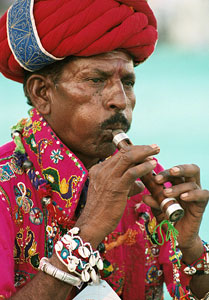 |
|
|
|
|
Stage Art - Bhavai
A typical folk drama of Gujarat called Bhavai is performed
in village and temple grounds by professional communities of
North Gujarat - the Taragalas, Bhojakas, etc. The word
Bhavai is derived from the Sanskrit word "Bhava" meaning
expression of emotion. The Bhavai drama is a continuous
performance lasting the whole night in which many "veshas"
are performed in the open without any stage equipment. These
Veshas depict episodes from the social life of communities
in the countryside, focusing in a satirical or farcical way
the characteristics of certain sections - Banias, Bohras,
wandering tribes, etc. Continuous playing on the Bhungal, a
very long wind brass instrument, before and during the
performance calls the rural patrons to the scene of the
Bhavai. Women are strictly tabooed from taking part in the
Bhavai. Their role is performed by the male artists which
makes the entire drama more ridiculous. The repertoire of
the Bhavai is limited to about three dozen veshas, the
authorship of which is attributed to Asait. |
|
|
|
Dance
Gujarat has a unique distinction of having a legendary
origin of folk dance forms. There are certain folk
dances which typically represent the community
activities and their functional aspect. The Tippani
folk dance is a dance of such a variety in which women
labourers engaged in construction work, strike the
floor with long sticks called Tippani. They have a
rhythmic music. The tribes in Gujarat have their own
forms of the folk dances. The costumes and the
instruments used during these folk dances are typical
folk costumes which mostly consist of a short coat
called Kedia with tight sleeves with embroidered
borders and shoulders, tight trousers like the
Churidars and colourfully embroidered caps or coloured
turbans and a coloured waist band. The most popular
and known folk dances of Gujarat are Garba, Garbi,
Rasaka, Tippani, Padhar-Nritya, Dangi-Nritya etc. Most
of these dances have a circle of Mandala as the basic
Choreographic pattern. |
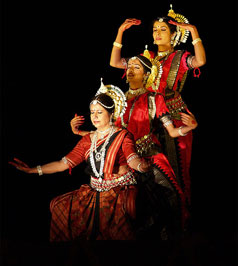 |
|
|
|
|
Hallisaka
Hallisaka is a group dance, in a circular formation with the
hands joined together forming a chain. The time (Tala) is
kept by clapping and is accompanied by singing. A young man
stands in the middle of the damsels. The feet movements,
toes, heels and legs first start their journey to explore
rhythmic expression measured steps, long, short, quick, and
slow accompanied in single, double and triple timings.
Dangi Nrita
The Gangis are unique tribals, a blend of Gujarati and
Maharashtrian culture mixed harmoniously with original
Dravidians. The dance performed by Dangis is called Dangi
Nritya. Men and women join hands forming a chain or
shrinkala making serpentine movements with one of them
leading. The movements is very fast, swift and create
various choreographic patterns in a fraction of a second.
Each variety of step is called 'Chala' and there are about
27 varieties of these chalas. One of the most amazing sights
of this dance is the creation of a human pyramid. |
|
|
|
Rasa
Rasa is a form of dance which is supposed to belong to
Kutch and Suarashtra is performed all over Gujarat.
The rasa traditions are as old as the Puranic period.
In various parts of the country, Rasa is danced in
different manners. The main feature of Rasa is dancing
in a circle by men and woman, to the accompaniment of
musical instruments and keeping time either by
clapping or beating of two sticks. The number of
dancers go from 8 to 64 couples, who also sing the
song. There are three varieties of Rasaka. Danda
Rasaka is the Rasa dance where Danda or sticks are
used. In the |
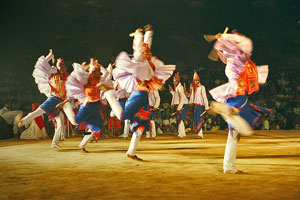 |
|
|
mandala or Tala Rasaka
Rasa dance clapping is used. Lata Rasaka is the Rasa dance
where dancers cling to each other and dance like a creeper
to a tree.
Most of the art traditions of Gujarat trace their origin to
the mythological times of Lord Krishna. He is said to have
been an exponent of art of dancing. Raas Nritya is a form of
dance performed by Lord Krishna with Gopikas. The Dandia
variety of the Raas Nritya of Gujarat is generally performed
by a group of youthful persons, both males and females, who
move in circles to measured steps, beating time with small
sticks (called dandia) singing to the accompaniment of Dhol,
Cymbals, flute or Shehnai. When the beat is given by the
clapping of palms and performed only by males, it is called
Garbi. The Gof variety of the raas is an intricate
performance where the performers hold coloured strings
attached to a top, moving in circles weaving and unweaving
different patterns. The Mers of Saurashtra are known for
their folk dance called the Mer Raas. White shepherds
perform what is called the Gher Raas. The Gheria Raas is a
dance performed by the agriculturists of south Gujarat. |
|
|
|
Garba
Dance
Garba Dance is a popular folk dance of Gujarat. It is
a circular form of dance performed by ladies on the
Navaratri days, Sharad Purnima, Vasant Panchami, Holi
and other festive occasions. The word Garba is derived
from the word Garbha Deep meaning a lamp inside a
perforated earthen pot. The light inside the
perforated earthen pot symbolize the embryonic life.
In this folk dance, ladies place the pot with the lamp
on their heads and move in circles, with a photograph
of the goddess or a lamp in the centre singing and
clapping their palms or snapping their fingers, to the
accompaniment of folk instruments. The actual
|
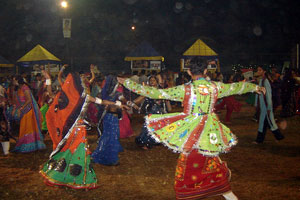 |
|
|
performance begins at night after the women finish their
household work. The dancing begins with slow tempo and
reaches a fast tempo. The rhythm is kept by a Dholi or
drummer who sit in the centre. Sometimes, women carry on
their heads 'Mandavali' a small canopy made of bamboo chips
covered with a red silk piece of cloth. They dance with it
and later put it in the centre. Mandavali symbolises the
temple of the goddess. Each community wears different
clothes. In Saurashtra, women wear embroidered petticoats (Ghaghara),
a backless choli (Kapdu) and a head cover (odhani) with lots
of silver and head ornaments. Males wear Kediyum (shirt),
Vajani (trouser) and Rumal, a printed head piece with silver
ornaments on the waist, neck and hands. The musical
instruments used for Garba are mainly thedrum or dhol and
Nal. Garba songs are mostly in praise of Mother Goddess Amba
describing her form, powers, and invoking her blessings.
Also there are Garbas describing seasons and social themes
of domestic and married life. |
|